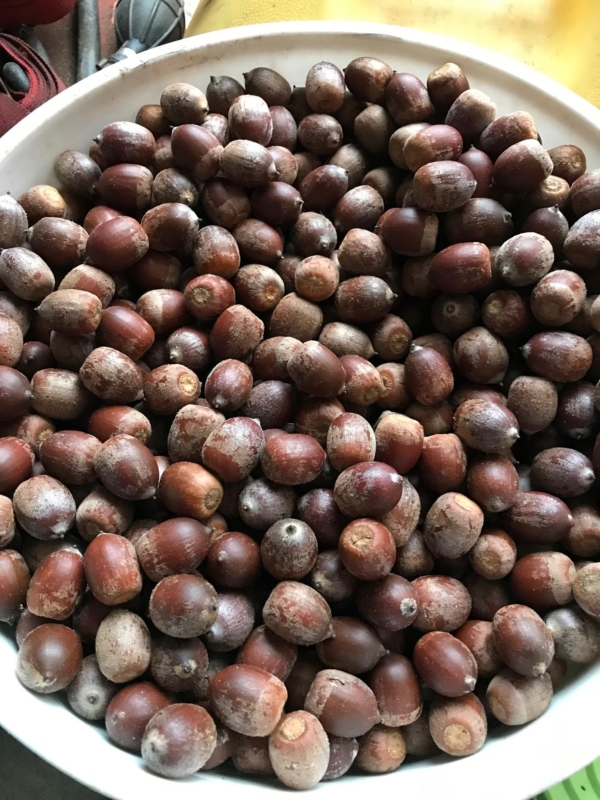Hunting Acorns and Other Mast for Whitetails
With sweet October rolling in, many deer hunters have kicked off their deer seasons and have been putting in some tree stand time. Any time you can get in a tree to be part of nature is time well spent. But when you can target high-priority areas in mid to late October, you could set yourself up for a very exciting hunt. As Michael was surveying his farm recently and kicking off pecan harvesting season, he noted some similarities in timing with white oak trees dropping acorns. In the video below, he shares some tips with you about what you should be looking for when hunting acorns and how you can use that information to produce better deer hunting.
Southern Oak Trees and Whitetails
While most deer hunters have heard about the importance of hunting acorns when it comes to deer hunting in the fall, the fact is that there are a lot of different oak trees. How do you know which ones you should target? Are different species better than others? In this section, we’ll talk about a handful of the various oak varieties that produce well for southern states, but there’s a lot of similarities for you northern hunters out there too. There are two basic kinds of oak trees to consider (red and white) and multiple species within each category.
White Oaks
Trees in the white oak category produce acorns in one season (annually) and acorns generally germinate right after hitting the ground. Most white oak acorns have meat that is sweeter than those in the red oak family, so deer will hit them hard when they start falling. So if you’re interested in hunting acorns to find deer, focus your efforts on white oaks earlier in the season. Their leaves usually have rounded tips to the lobes as well.
- White Oak – these trees are spread all across eastern North America. The bark tends to have a whitish hue to it, and the leaves have rounded lobes. The acorns can be up to an inch or more long and vary in color from light brown, dark brown, purple, and even green.
- Swamp White Oak – this tree has a lot in common with regular white oaks, except the leaves have fewer lobes. It produces annual acorns about the same size as white oaks, but this tree tends to grow in poorly-drained soils (hence the name).
- Bur Oak – often recognized by their spreading, gnarled branches, bur oaks also have distinct leaves with deeply cut, rounded lobes. They produce acorns each year that are 1-2 inches long with a scaly/hairy cup covering the top.
- Overcup Oak – these moderate-sized trees produce annual acorns that are 1-2 inches in length, and covered with a large hairy-looking cup on top.
- Swamp Chestnut Oak – this medium- to large-sized tree produces leaves with wavy, rounded teeth, and it occurs on moist or floodplain soils. The annual acorns are 1-1 ½ inches in length and very sweet.

Red Oaks
Trees in the red oak category usually take two seasons to produce mature acorns (biennial). The acorns are pollinated in one season but mature the following season. Acorns from red oak trees are bitter tasting compared to white oak acorns. For that reason, deer usually leave red oak acorns alone until later in the season (after white oak acorns are gone). In terms of hunting acorns, try to keep some red oak stands in your mind for later in the season. Their leaves usually have pointed lobes.
- Northern Red Oak – despite their name, northern red oaks grow throughout the southeast as well. There is a southern red oak too. Once mature, this variety can produce substantial acorn crops, and each acorn is about ½-1 ¼ inches in length.
- Water Oak – these trees can grow to 100 feet, and they occur all across the southeast in wet, lowland areas. Acorns are biennial and measure about ½ inch in length.
- Scarlet Oak – this fast-growing tree can be very tall (120 feet), and the leaves have deep lobes with sharp, pointed tips. The small acorns are produced biennially and are often between ½-1 inch in length. They occur across the south.
- Black Oak – growing up to 110 feet and identified by its dark black bark, this tree has sharp-tipped leaves and biennial acorns that are about ¾ inch long.
Other Mast Trees for Whitetails
Obviously, we’ve spent a lot of time on hunting acorns and oak trees, but there are a lot of other mast trees that work well for southern deer hunting. Soft mast trees produce soft, fleshy fruits that are very attractive to whitetails. They are usually highly digestible and contain a lot of carbs and sugars. Hard mast trees produce nuts and seeds that are more similar to acorns. They tend to be higher in fats and carbs. Here are just a few:
- Apple and crabapple
- Pear
- Persimmon
- Chestnut
- Pecan
Strategies for Hunting Acorns
There are literally dozens and dozens of other oak and mast trees that grow throughout the southeast alone, not to mention the rest of the whitetail range. But now you have an idea what you should be looking for. So how do we use that information to form a strategy for hunting acorns?
- Go Scouting – October is a great time to scout some new public or private parcels and see what kind of deer sign is out there. Keep an eye on the ground for fallen acorns as you go. If you can find a cluster of white oaks that are dropping acorns in an otherwise secluded spot, mark it on your phone and hang a trail camera as soon as you can! If it’s located between a food plot/ag field and a bedding area, you are sure to find some bucks hitting it.
- Remote Monitoring – This is the really beautiful part of this approach. Ideally, you don’t want to check your trail camera often as you could start pressuring or spooking the deer using your new honey hole. When you hang a cell cam, like the Bushnell® Cellucore™, you’ll get notifications right to your phone when a good buck starts showing up. To focus the activity in a larger oak flat on your camera location, look for an existing scrape or put in a mock scrape. You might also try putting Urge Whitetail Doe Full Estrous Attractant and/or King O’ The Woods Whitetail Full Rut Buck Attractant out to pull them in closer for a better picture.
- Right Conditions – Once you have a deer coming in, it’s time to plan. Check out a scouting app, like BaseMap™, to view your hunting location compared to the current and upcoming weather conditions. When the weather conditions are right, sneak in with a climber or hang-on stand and wait to catch a buck looking for a midday snack.
As a bowhunter, it’s magical when you can find a productive oak flat that is raining acorns down in October. Many other native food sources are dwindling, agricultural fields are an unknown, and your fall food plots might not be ready this time of year. So we hope you focus on hunting acorns, and end up finding a great whitetail instead.



